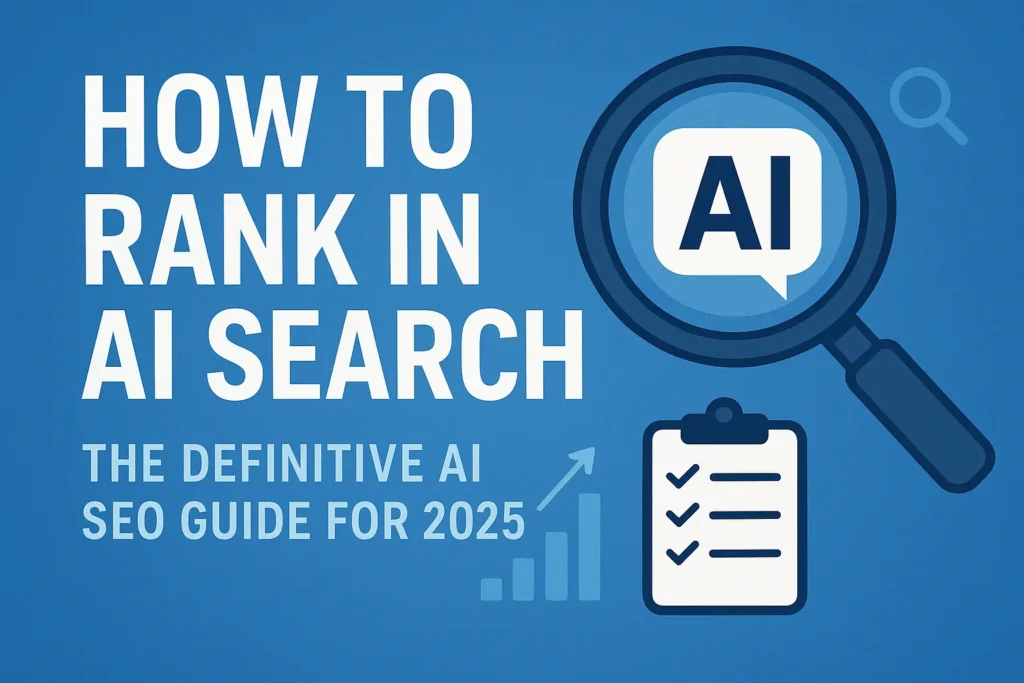In the evolving era of generative AI, the way we approach SEO is shifting. No longer is it enough simply to optimise for Google’s traditional algorithm. You also need to make your content AI friendly so that it is cited, surfaced, and trusted by large language models (LLMs), chatbots, and AI summarisation engines.
In this article, we dive into how to rank in AI search, explain what AI SEO truly means now, and give you a roadmap to outrank competitors.
1. What is AI Search, and Why It Matters
AI search refers to search experiences powered or augmented by generative models, summarisation engines, and answer engines (e.g. ChatGPT, Bing Chat, Perplexity, Google’s AI Overviews / SGE). Rather than showing ten blue links, these systems often synthesise a single response, citing trusted sources.
Because AI engines frequently draw information from credible websites, if your content is well structured, authoritative, and aligned with user intent, you increase your chance of being cited, not just ranked. In effect, AI search demands a hybrid of SEO, content authority, and machine readability.
Academic research calls this shift Generative Engine Optimization (GEO), a model that emphasises earned media, entity signals, and content engineered for machine extraction.
2. AI SEO vs. Traditional SEO (and AEO, GEO)
It helps to clarify terminology:
- SEO (Search Engine Optimisation): Optimising for conventional search engine rankings (Google, Bing).
- AEO (Answer Engine Optimization): Aiming to appear in featured snippets, knowledge panels, or zero-click answer boxes.
- GEO (Generative Engine Optimization): Tailoring content to be used by generative AI systems — being cited rather than just ranked.
AI SEO now blends all three. You must still rank (SEO), aim for direct answers (AEO), and ensure your content is usable by AI (GEO). Many best practices overlap, but AI SEO places extra emphasis on clarity, citations, entity signals, and structured formatting.
3. Key Signals That AI Engines Use
To succeed in AI search, you need to think not just like a human reader, but also like a model that must decide what to quote. Here are some of the core signals:
| Signal / Feature | Description | Why It Helps AI SEO |
|---|---|---|
| Concise, direct answers | Leading with a short, factual answer before elaborating | AI summarisation engines tend to pick up the clearest statements |
| Semantic richness | Use synonyms, LSI keywords, related terms, entity names | Helps AI understand topical breadth and context |
| Structured formatting | Headings, bullet lists, numbered steps, FAQs | Easier to parse programmatically |
| Schema / structured data | FAQ schema, article markup, how-to schema, entity markup | Signals precise roles and relationships for AI to interpret |
| Authority & citations | Quoted sources, external references, data, expert voices | AI favours content that can be traced to trusted origins |
| Recency / freshness | Regular updates, “last updated” tags | AI systems prefer current information, especially for fast-changing topics |
| Topical depth / coverage | Cover subtopics, related questions, gaps | Becoming a comprehensive resource increases the chance of being referenced |
| User signals / engagement | Dwell time, low bounce, links, social engagement | Human-level metrics still feed into AI models’ reinforcement signals |
| Brand & Entity signals | Author profiles, “About” pages, internal linking, mentions elsewhere | Helps AI associate authority and identity |
Simple techniques like adding citations, quotes, and statistics can improve visibility in AI powered responses by 30–40%.
In short: AI SEO is as much about being valuable and credible as it is about optimisation.
4. Step-by-Step Strategy: How to Rank in AI Search
4.1 Topic & Keyword Strategy for AI
- Start from user intent and real questions
Analyse customer support logs, forums, Reddit, Quora to see how people phrase their questions. You want long tail queries like “how to rank in AI search” or “will ChatGPT cite my blog?” - Cosine / semantic clustering
Use tools or cluster semantically related keywords (e.g. “AI search visibility”, “AI SEO strategies”, “rank in generative search”) so your content signals topic coverage. - Prioritise “AI triggering” keywords
These are terms that often lead to AI overviews or generative answers (e.g. “best practices in AI search”, “AI ranking factors”). - Design content clusters
Build a pillar page (e.g. “How to Rank in AI Search”) and link to sub articles (e.g. “AI SEO tools”, “Schema markup for generative search”) – this strengthens topical authority.
4.2 Content Structure & Style
- Lead with a concise answer (the “anchor sentence”)
Keep it within 40–60 words if possible. Then expand with context. - Use question headings (H2, H3) phrased as queries or conversational prompts
E.g. “What signals do AI engines use?” - Break down complexity
Use bullet points, numbered steps, bolding key terms, tables, infographics - Weave in LSI / semantic terms
E.g. “generative engine”, “AI summarisation”, “answer engine”, “citation token”, “entity linking” - Embed quotes, data, and external citations
Include statements from published research, industry analysts, or case studies — make sure to cite them properly - Converse naturally
Use a human tone, transition words, examples, mini anecdotes — AI engines reward natural phrasing over robotic repetition.
4.3 Technical & On-Page Enhancements
- Schema / structured data
- FAQ schema
- Article schema
- HowTo schema (if appropriate)
- Breadcrumb schema
- Organization / Person / Author schema
- Semantic URL & meta tags
Your URL should mirror the topic (e.g. /how-to-rank-in-ai-search). Meta titles and descriptions should act like mini answers. - Mobile first & speed optimisation
Core Web Vitals, image optimisation, cache, lightweight scripts
AI engines and human users both penalise slow pages - Internal linking & topical clusters
Link to related subtopics; use descriptive anchor text - Clean markup, headings, alt text
Use H1 for the main title, then H2 / H3 hierarchy. Alt text on images should describe content meaningfully. - Canonical tags & pagination handling
Prevent duplicate content issues, ensure AI models see your preferred version - XML sitemap, robots.txt, crawlability
Ensure bots (traditional and AI crawlers) can access your content
4.4 Authority, Citations & E-E-A-T
- Show credentials and experience
Use an author byline, short bio, links to professional credentials or profile pages - Quote authoritative sources
Use data, studies, or industry quotes. AI engines value external validation - Earn mentions & backlinks
Publish original research, infographics, guest articles, or use PR to be mentioned in external media - Engage communities & influencers
Social sharing, newsletter mentions, collaborations can drive citations which upstream AI models may observe - Update content regularly
Keep statistics, tools, and examples fresh. AI models are sensitive to stale data
4.5 Monitoring & Iteration
- Test via AI tools
Pose your target queries to ChatGPT, Bing Chat, Perplexity, Google SGE. See whether your content is used or cited. - Track AI citations
Use tools like Peec.ai or AI Visibility trackers to see where your domain is cited. - Monitor engagement metrics over raw traffic
Look at dwell time, scroll, pages per session - Compare competitors
What content are AI models citing from your niche? Reverse engineer their structures or sources - Update & expand
Add missing subsections, fresh data, new questions, refining language - A/B test anchor sentences, phrasing tweaks
Slight wording changes can influence which sentences AI picks up
5. Pitfalls to Avoid
- Keyword stuffing or over-optimisation
Strategy matters far less than substance. AI is smart enough to penalise unnatural repetition. - Using AI-generated text blindly
You must human edit, add voice, fact check, and add unique value - Ignoring entity and brand signals
If there’s no author or entity identity, AI may discard your content as unknown - Overreliance on one AI engine
Different generative systems use different citation sources; diversify your strategy - Neglecting updates
A beautiful article from 2021 may be bypassed if it’s no longer relevant - Weak technical SEO
No matter how good your content, if your page is slow, unresponsive, or unindexable, AI models won’t reach it
Conclusion
Ranking in AI search is not just a hack. It’s a discipline: a hybrid of content integrity, technical polish, and strategic citation building. If you:
- craft content that deserves to be cited,
- structure it clearly for machines,
- back it up with authority,
- monitor and improve over time,
then you stand a much better chance of being surfaced by AI engines.
FAQs
Not exactly. While strong Google rankings increase your chance of being cited, AI search systems also look for authoritative, well structured, and machine readable content. Even if you’re in the top 10, if your content lacks clarity or citations, AI may bypass it.
Yes – but treat AI output as a draft. You must add a unique angle, human voice, data, quotes, and revise for readability. AI helps with ideation but shouldn’t fully replace human judgement.
Aim to review high priority pages every 30, 90, and 180 days. Refresh statistics, add new subtopics, validate external links. Even small updates (e.g. new data, examples) can help maintain or regain visibility.
Analyse the content that is being cited. Maybe the phrasing, clarity, or lead anchor sentence is stronger than yours. You can A/B test alternative opening sentences, better structuring, or more succinct summaries to attract AI. Also, try rewriting or reordering sentences so your clearest answer is front and centre.
It depends on your niche, domain authority, and how many AI engines index you. Typically, after robust optimisation and content updates, you might begin to see citations within 4–12 weeks. Monitoring, iteration, and consistency are key.



